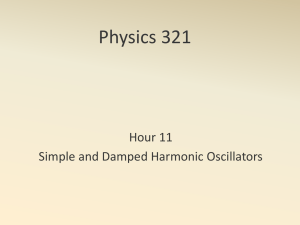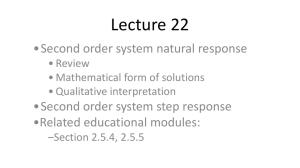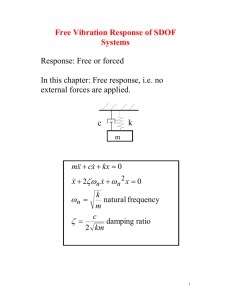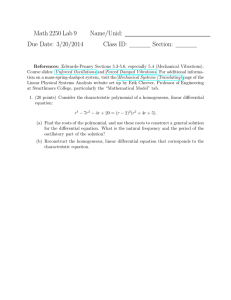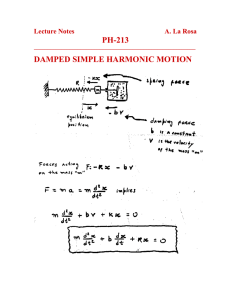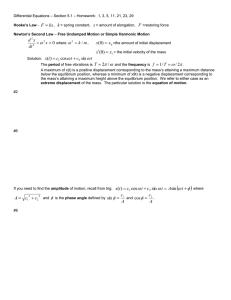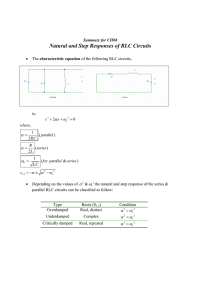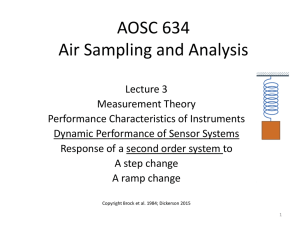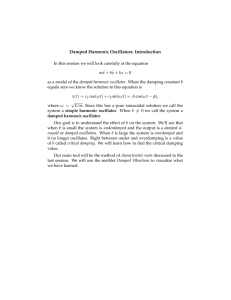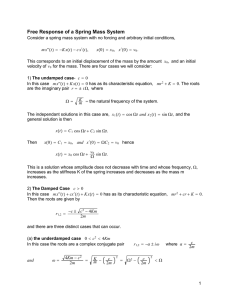Math 266 Spring Problems Hansen Undamped Linear Springs The
advertisement
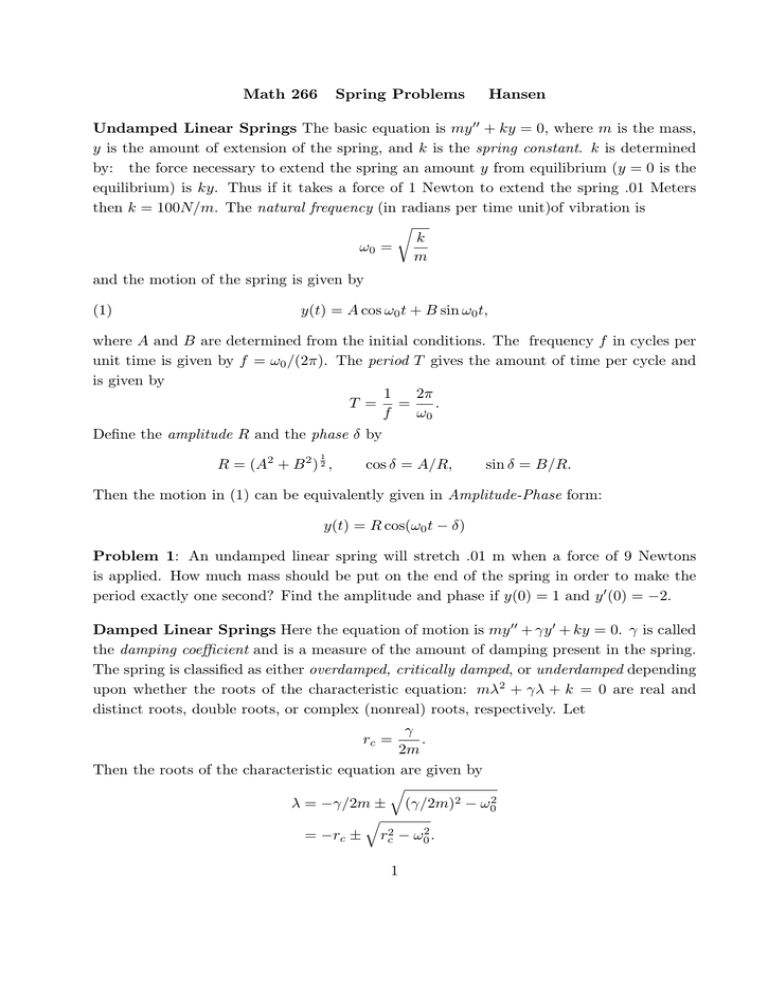
Math 266 Spring Problems Hansen Undamped Linear Springs The basic equation is my 00 + ky = 0, where m is the mass, y is the amount of extension of the spring, and k is the spring constant. k is determined by: the force necessary to extend the spring an amount y from equilibrium (y = 0 is the equilibrium) is ky. Thus if it takes a force of 1 Newton to extend the spring .01 Meters then k = 100N/m. The natural frequency (in radians per time unit)of vibration is r k ω0 = m and the motion of the spring is given by (1) y(t) = A cos ω0 t + B sin ω0 t, where A and B are determined from the initial conditions. The frequency f in cycles per unit time is given by f = ω0 /(2π). The period T gives the amount of time per cycle and is given by 1 2π T = = . f ω0 Define the amplitude R and the phase δ by 1 R = (A2 + B 2 ) 2 , cos δ = A/R, sin δ = B/R. Then the motion in (1) can be equivalently given in Amplitude-Phase form: y(t) = R cos(ω0 t − δ) Problem 1: An undamped linear spring will stretch .01 m when a force of 9 Newtons is applied. How much mass should be put on the end of the spring in order to make the period exactly one second? Find the amplitude and phase if y(0) = 1 and y 0 (0) = −2. Damped Linear Springs Here the equation of motion is my 00 + γy 0 + ky = 0. γ is called the damping coefficient and is a measure of the amount of damping present in the spring. The spring is classified as either overdamped, critically damped, or underdamped depending upon whether the roots of the characteristic equation: mλ2 + γλ + k = 0 are real and distinct roots, double roots, or complex (nonreal) roots, respectively. Let γ . rc = 2m Then the roots of the characteristic equation are given by q λ = −γ/2m ± (γ/2m)2 − ω02 q = −rc ± rc2 − ω02 . 1 Overdamped: If rc > ω0 , then the spring is overdamped and the solution is of the form: y(t) = c1 eλ1 t + c2 eλ2 t . One characteristic of overdamped systems is that y(t) changes sign at most once. The spring behaves more like a damper than a spring. If the spring is highly overdamped, then y(t) will decay very slowly to zero. Critically damped: If rc = ω0 then the spring is critically damped and the motion is given by y(t) = c1 e−rc t + c2 te−rc t . (For this reason rc is called the critical damping rate.) In a critically damped spring, γ is at the critical value which makes solutions decay most rapidly. Underdamped: If rc < ω0 then the spring is underdamped. This means that the motion of the spring is oscillatory. Let q µ= ω02 − rc2 . Then the motion of the spring is given by (2) y(t) = Ae−rc t cos µt + Be−rc t sin µt. Thus µ gives the rate of oscillation (in radians per unit time) and is called the quasi frequency of the damped spring. Problem 2 Given that m = 3, k = 12, y(0) = 0, y 0 (0) = 2, find the motion of a damped linear spring if (a) γ = 3, (b) γ = 12, (c) γ = 15. Classify the type of damping in each case. Forced Oscillations We will only be concerned with the case where the spring is underdamped and being forced by an oscillator f (t) = F0 cos ωt. Thus the equation of motion is my 00 + γy 0 + ky = F0 cos ωt. The quantity ω will be called the input frequency. The motion is given by y = yc +Y , where yc is the complementary solution given in (2), and Y is a particular solution. yc is called the transient solution because its the part of the solution depends upon the initial conditions and decays out after a short time. yp is the part of the solution that depends upon the input and is called the steady-state solution because after the transient solution dies out the solution settles down to a steady cycle. This cycle can be put in an amplitude-phase form as indiated in (3), (4) of sec. 3.9. With R and δ defined this way Y = R cos(ωt − δ). 2 Thus R represents the amplitude and δ gives the phase shift. An important observation is that when γ is small, the amplification becomes quite large near the frequency ω = ω0 . This is called resonance. All mechanical and electrical systems have resonances. Usually these are to be avoided (e.g., design of auto bodies), and other times are taken advantage of (as in microwave ovens, spectroscopy, amplifiers). Thus its often important to know the frequency response of the spring, that is, the behavior of the phase and amplification as a function of the input frequency. The most important feature of the amplitude F.R. is the frequency ωm which gives the maximum amplification. This and the corresponding amplification at this frequency are given described in (6), (7) of sec. 3.9. Problem 3 Suppose a damped linear spring has mass 1kg, k = 100 (Newtons/m) and γ = .1 (Newtons/(m/s)). Find the steady-state solution (in amplitude-phase form) corresponding to the input f (t) = cos ωt for (a) ω = 1, (b) ω = 10, (c) ω = 20. What is ωm ? Draw a graph of the frequency response. (That is, a graph of R(ω) and a graph of δ(ω).) If you do these graphs by hand, draw to scale, preferably on graph paper. 3

